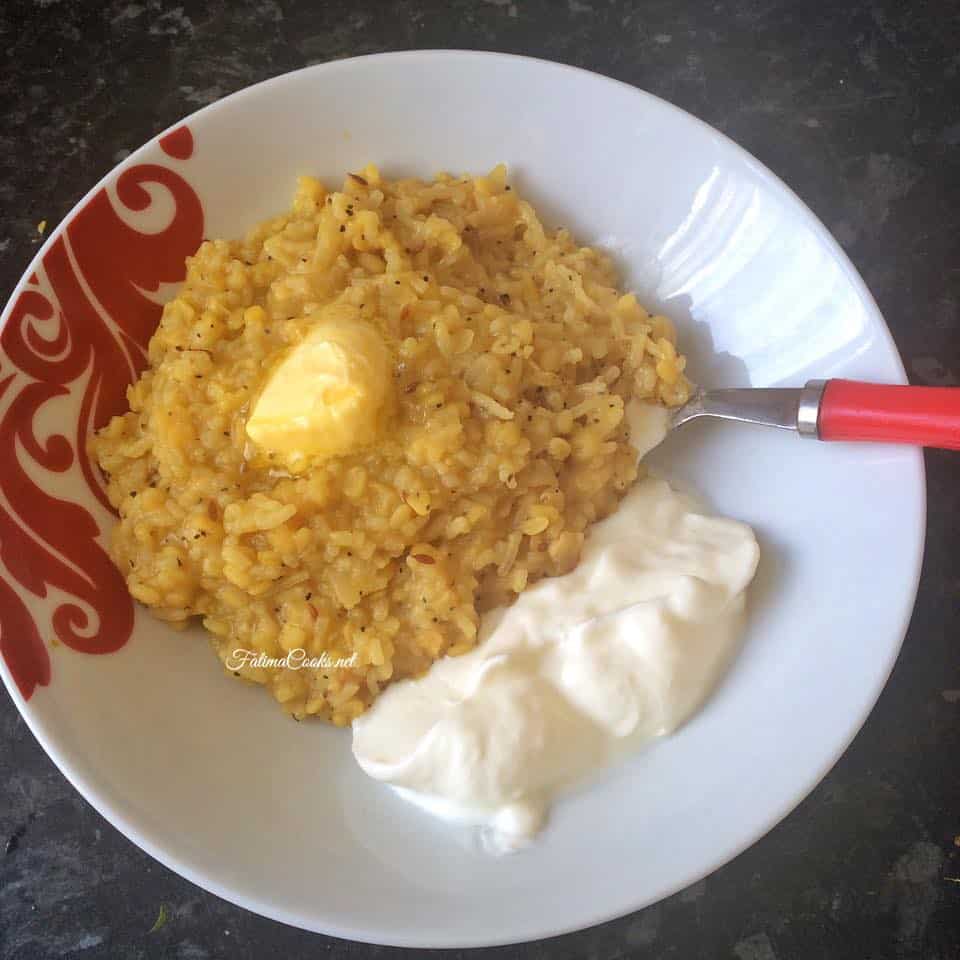Khichdi for my family has always been something that’s made when someone is ill, has an upset stomach or for babies being weaned onto solid food. I reckon it’s like that in a lot of Pakistani households. The reasoning is that Khichdi is easier to take in and digest since it has a very mild flavour, isn’t heavy on the spices and is very soft. I remember my Mother cooking a small pot of Khichdi on the daily for my little brother seven years my junior when he was being weaned onto solids. This Khichdi was super soft, moist and buttery. Occasionally my Mother would add small chunks of potatoes that looked like they were melted into the rice, or chicken. I won’t lie, I would wait for my brother to (inevitably) have some leftovers for me to devour. Come to think of it, I’ve no clue why I just didn’t ask my Mother to make some for me too. Ah, to be a kid again, eh?
What is Khichdi?
Khichdi is a rice and lentil medley dish, somewhat a cross between a pilaf and a soup. It’s a simple recipe, mild in flavour but very soothing. Some variations contain vegetables, beans, even meat. This recipe is for a simple Dal Khichdi, which contains only lentils and rice.
What kind of lentils can you use in Khichdi?
You can use any type of lentils for Khichdi. I used masoor and moong daal in this recipe, however literally any kind can be used. Additionally, the ratio of rice:lentils is also up to you. I used 50% rice and 50% daal - I just prefer to bulk it up evenly. I’ve found some people prefer 30% daal and 70% rice - it’s purely your own choice and fear not, messing up the ratio will not mess up your Khichdi! Any changes you can make are listed in the ’notes’ section below the recipe
What is Khichdi good for?
I love a bowl of Khichdi anytime I’m not in the mood for a full-blown taste-bud experience. Cooked in my style, with a slightly heavy hand on the black pepper and an emphasis on the delectable aroma of cinnamon, Khichdi makes for an ideal lunch on a lazy day. Khichdi is also a fantastic meal for your little ones - my daughter particularly has been a complete Khichdi lover ever seen we were weaning her onto food. You can keep a light hand on the black pepper if your child is new to food or sensitive to spice. My girl has an impressively good tolerance to spice, so I use the same amount of black pepper as I would for myself. Khichdi will also have your back on a sick day - sometimes something mild, soft and bland is all you can stomach. Fear not, you’ve come to the right recipe if this is you.
How to serve Khichdi
Khichdi is best deserved with a knob of butter and a dollop of yogurt. In fact, never have I seen a plate of Khichdi in my family without a side of yogurt. It seems quite unthinkable. You can also serve it with some achaar (pickle) and a tomato chutney. If you want to serve it alongside a curry, I would highly recommend something simple and with shorba, like Aloo Gosht or Chicken Salan. Many recipes also serve Khichdi with a Tadka - i.e., frying some onions alongside additional aromatic such as curry leaves or chilli in oil/ghee and then pouring over. This gives a beautiful, deep and rich flavour to the Khichdi. You can totally do this too. I haven’t done this in this particular recipe as I don’t tend to add a Tadka myself. But if this is what you’re used to, go for it!
Top Khichdi Tips
The more you brown your onions in the initial step, the darker your khichdi will be. Keep this in mind if you have a picture of how coloured you’d like the end result! For a great addition, try adding vegetables like cubed potatoes, peas, sweetcorn, carrots etc to this! For potatoes or carrots, I would recommend adding them around 20 minutes before the end. Sweetcorn and peas which are frozen are totally fine being added about 10 minutes before the end. I have been known to add grated vegetables into Khichdi to get some extra nutrition in. Disclaimer: your Khichdi may change colour, depending on what veggies you add. Not a fan of the buttery dollop at the end? No worries. You can omit that and replace it with a lovely tadka of fried onions or anything else you fancy. Green chillis, cumin seeds, garlic and mustard seeds also make good additions.
Enjoy, with love x
📋 Recipe
Enter your email & I’ll send it right over. Plus, you’ll get bonus Pakistani food-goodness from Fatima Cooks, like new recipe alerts, exclusive email-only recipes + more! By submitting this form, you consent to receive emails from me. Your details are secure. Opt-out any time.


